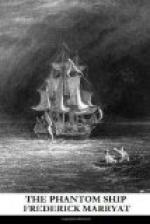Prefatory Note
THE PHANTOM SHIP is the most notable of the three novels constructed by Marryat on an historic basis, and like its predecessor in the same category, Snarleyyow, depends largely for its interest on the element of diablerie, which is very skilfully manipulated. Here, however, the supernatural appearances are never explained away, and the ghostly agencies are introduced in the spirit of serious, if somewhat melodramatic, romance. Marryat’s personal experience enabled him, with little research, to produce a life-like picture of old Dutch seamanship, and his powers in racy narrative have transformed the Vanderdecken legend into a stirring tale of terror. The plot cannot be called original, but it is more carefully worked out and, from the nature of the material at hand, more effective than most of Marryat’s own. He has put life into it, moreover, by the creation of some genuine characters, designed for nobler ends than to move the machinery.
Amine, indeed, as Mr Hannay points out, “is by far his nearest approach to an acceptable heroine.” Her romantic and curiously superstitious disposition is admirably restrained by strength of will and true courage. The scenes of the Inquisition by which she meets her death are forcibly described. Philip Vanderdecken is a very respectable hero; daring, impetuous, and moody, without being too improbably capable. The hand of destiny lends him a dignity of which he is by no means unworthy. Krantz, the faithful friend, belongs to a familiar type, but the one-eyed pilot is quite sufficiently weird for the part he has to play. For the rest we have the usual exciting adventures by sea and land; the usual “humours,” in this case certainly not overdone. The miser Dr Poots; the bulky Kloots, his bear, and his supercargo; Barentz and his crazy lady-love the Vrow Katerina; and the little Portuguese Commandant provide the reader with a variety of good-natured entertainment. It was an act of doubtful wisdom, perhaps, to introduce a second group of spirits from the Hartz mountains, but the story of the weir-wolves is told simply, without any straining after effect.
The general success, however, is marred by certain obvious failures in detail. The attempt to produce an historic flavour by making the characters, during their calmer moments, talk in would-be old English is more amusing than culpable; but the author’s philosophy of the unseen, as expounded by Amine or Krantz, is both weak and tiresome, and his religious discourses, coloured by prejudice against the Romanists, are conventional and unconvincing. The closing scene savours of the Sunday-school.
But these faults are not obtrusive, and the novel as a whole must take a high place among its author’s second-best.
The Phantom Ship appeared in The New Monthly Magazine, 1838, 1839. It is here reprinted from the first edition, in three volumes. Henry Colburn, 1839.




